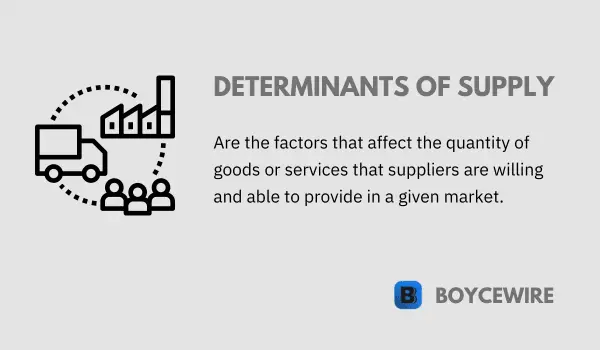Determinants of Supply: What it is & Examples

What are Determinants of Supply?
In the complex dynamics of market economics, the concept of supply plays an indispensable role. Supply, in simple terms, can be defined as the quantity of a product or service that producers are willing and able to sell in the market at different prices, over a given time period. The notion of supply does not function in isolation; it is influenced by various factors known as the ‘determinants of supply’.
These determinants influence the willingness and ability of producers to offer goods and services for sale, thus affecting the overall market supply. Understanding these factors is crucial for both businesses and policy-makers as they strive to interpret market conditions, make informed decisions, and forecast future trends.
Key Points
- As the price of a product increases, suppliers are more willing to supply it to the market.
- Higher production costs can reduce the quantity supplied by making it less profitable for suppliers.
- Advances in technology can lower production costs and increase the supply of goods and services.
- The availability and accessibility of resources, such as raw materials and labor, can impact the ability of suppliers to produce and supply goods.
Understanding the Determinants of Supply
In the context of economics, ‘supply’ refers to the total amount of a specific good or service available to consumers at a given time. The ability and willingness of producers to offer goods or services on the market largely dictate the supply. Various internal and external factors can influence this supply capacity, and these are referred to as ‘determinants of supply’.
These determinants play a pivotal role in shaping the supply curve of a market, which is a graphical representation of the quantity of a good that producers are willing to sell at different prices. Any change in these determinants can cause a shift in the supply curve, either increasing or decreasing the supply for the same price.
The determinants of supply are an integral part of market dynamics and greatly aid economists and policymakers in predicting market behavior and framing effective economic strategies. They enable an understanding of why a producer might increase or decrease the output of a product, which is a fundamental aspect of economic analysis and forecasting.
Recognizing and understanding the determinants of supply is crucial for businesses, too, as it assists them in making informed decisions about production levels, pricing, and strategy according to market conditions.
Examples of Determinants of Supply
- Production Costs The cost of production significantly impacts the quantity of goods that a supplier is willing and able to produce and supply to the market. Factors that influence production costs include raw material prices, wage rates, and the cost of machinery or other capital inputs. An increase in production costs typically decreases supply as it becomes less profitable for firms to produce, while a decrease in production costs increases supply.
- Technological Advances Improvement in technology can enhance productivity and efficiency in production, reducing the cost of production, and thereby increasing supply. A technological setback, on the other hand, might increase production costs and decrease supply.
- Prices of Related Goods The supply of a product can also be influenced by the prices of related goods. For instance, if the price of a good that can be produced using the same resources rises, suppliers might switch their production to that good, decreasing the supply of the original good.
- Number of Producers The more producers or firms in the market, the greater the market supply. If firms enter the market, the market supply increases; if firms exit, the market supply decreases.
- Expectations If producers expect higher prices in the future, they may reduce supply now to sell more in the future at a higher price. Conversely, if lower prices are expected in the future, producers may choose to supply more now.
- Government Policies and Regulations Government intervention in the form of taxes, subsidies, quotas, etc., can significantly impact the cost of production and, hence, supply. For example, a subsidy would decrease the cost of production and increase supply, while a tax would increase the cost of production and decrease supply.
Understanding these determinants helps suppliers make strategic decisions about production and helps buyers and economists predict changes in market conditions.
Changes in Supply
Changes in supply can occur due to any changes in the determinants of supply. It’s important to distinguish between two types of changes in supply: a change in supply and a change in the quantity supplied.
- Change in Supply This refers to a shift in the entire supply curve, caused by factors other than price. For instance, if a technological advancement reduces the cost of production, it can increase supply at all price levels, shifting the supply curve to the right. Conversely, a new tax on production would increase costs and decrease supply at all price levels, shifting the supply curve to the left.
- Change in Quantity Supplied This refers to a movement along the existing supply curve in response to a change in price. For example, if the price of a good increases, producers will typically supply more of the good, resulting in a movement upwards along the supply curve. Conversely, if the price of a good decreases, producers will typically supply less, resulting in a movement downwards along the supply curve.
Understanding these changes in supply can help businesses, consumers, and policymakers make informed decisions about production, purchasing, and policy. By forecasting how changes in certain factors will affect supply, they can better anticipate market dynamics and respond accordingly.
Impact of Changes in Supply
The impact of changes in the determinants of supply can be far-reaching and vary greatly depending on the specific determinant that has changed, the nature of the product or service, and the specific market conditions. Here are some potential impacts:
- Price Fluctuations Changes in supply can lead to fluctuations in market prices. For instance, an increase in supply typically puts downward pressure on prices, assuming demand stays constant, which can benefit consumers. Conversely, a decrease in supply can push prices up, benefiting producers but potentially straining consumers.
- Producer Profitability Factors that increase supply can lead to higher potential sales volumes for producers, which can enhance profitability if costs are controlled. However, factors that decrease supply can reduce potential sales volumes and hurt profitability unless the firm can offset volume decreases with higher prices.
- Consumer Choices Supply determinants can impact the range and quality of goods and services available to consumers. Increased supply can result in more choices and better quality, while reduced supply can limit consumer options.
- Economic Health On a broader scale, changes in supply determinants can impact the health of industries, economies, and even global trade. For example, increased supply due to technological advancements can boost economic productivity, while decreased supply due to resource depletion can have negative economic impacts.
- Policy Implications Government policies often aim to influence the determinants of supply to achieve desired economic outcomes, such as promoting innovation or protecting the environment. Changes in these determinants can influence policy debates and decisions.
The ability to understand and predict the impact of changes in supply determinants is crucial for market participants and policymakers. This allows for proactive decision-making and responsive strategy development.
FAQs
The main determinants of supply include the price of the product, cost of production, technology and innovation, resource availability, government regulations and policies, expectations of future prices, number of suppliers, and external factors.
An increase in the price of a product generally leads to an increase in the quantity supplied, as suppliers are incentivized to supply more to take advantage of higher profits.
Higher production costs, such as increased labor or raw material costs, can reduce the profitability of supplying a product, leading to a decrease in supply.
Technological advancements can improve production efficiency, lower costs, and increase supply by enabling suppliers to produce more goods or services with the same amount of resources.
About Paul
Paul Boyce is an economics editor with over 10 years experience in the industry. Currently working as a consultant within the financial services sector, Paul is the CEO and chief editor of BoyceWire. He has written publications for FEE, the Mises Institute, and many others.

Further Reading
 Debt to Equity Ratio - The debt-to-equity ratio is a financial metric that compares a company's total debt to its total equity to assess its…
Debt to Equity Ratio - The debt-to-equity ratio is a financial metric that compares a company's total debt to its total equity to assess its…  Perpetuity: Definition, Formula, Types & Examples - In finance, perpetuity refers to the ongoing payment of a bond or security with no end date. Payments are made…
Perpetuity: Definition, Formula, Types & Examples - In finance, perpetuity refers to the ongoing payment of a bond or security with no end date. Payments are made… 